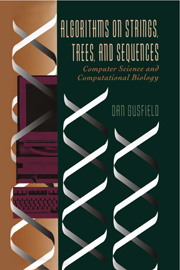Book contents
- Frontmatter
- Contents
- Preface
- I Exact String Matching: The Fundamental String Problem
- II Suffix Trees and Their Uses
- III Inexact Matching, Sequence Alignment, Dynamic Programming
- 10 The Importance of (Sub)sequence Comparison in Molecular Biology
- 11 Core String Edits, Alignments, and Dynamic Programming
- 12 Refining Core String Edits and Alignments
- 13 Extending the Core Problems
- 14 Multiple String Comparison – The Holy Grail
- 15 Sequence Databases and Their Uses – The Mother Lode
- IV Currents, Cousins, and Cameos
- Epilogue – where next?
- Bibliography
- Glossary
- Index
14 - Multiple String Comparison – The Holy Grail
from III - Inexact Matching, Sequence Alignment, Dynamic Programming
Published online by Cambridge University Press: 23 June 2010
- Frontmatter
- Contents
- Preface
- I Exact String Matching: The Fundamental String Problem
- II Suffix Trees and Their Uses
- III Inexact Matching, Sequence Alignment, Dynamic Programming
- 10 The Importance of (Sub)sequence Comparison in Molecular Biology
- 11 Core String Edits, Alignments, and Dynamic Programming
- 12 Refining Core String Edits and Alignments
- 13 Extending the Core Problems
- 14 Multiple String Comparison – The Holy Grail
- 15 Sequence Databases and Their Uses – The Mother Lode
- IV Currents, Cousins, and Cameos
- Epilogue – where next?
- Bibliography
- Glossary
- Index
Summary
In this chapter we begin the discussion of multiple string comparison, one of the most important methodological issues and most active research areas in current biological sequence analysis. We first discuss some of the reasons for the importance of multiple string comparison in molecular biology. Then we will examine multiple string alignment, one common way that multiple string comparison has been formalized. We will precisely define three variants of the multiple alignment problem and consider in depth algorithms for attacking those problems. Other variants will be sketched in this chapter; additional multiple alignment issues will be discussed in Part IV.
Why multiple string comparison?
For a computer scientist, the multiple string comparison problem may at first seem like a generalization for generalization's sake – “two strings good, four strings better”. But in the context of molecular biology, multiple string comparison (of DNA, RNA, or protein strings) is much more than a technical exercise. It is the most critical cutting-edge tool for extracting and representing biologically important, yet faint or widely dispersed, commonalities from a set of strings. These (faint) commonalities may reveal evolutionary history, critical conserved motifs or conserved characters in DNA or protein, common two- and three-dimensional molecular structure, or clues about the common biological function of the strings. Such commonalities are also used to characterize families or superfamilies of proteins. These characterizations are then used in database searches to identify other potential members of a family.
- Type
- Chapter
- Information
- Algorithms on Strings, Trees and SequencesComputer Science and Computational Biology, pp. 332 - 369Publisher: Cambridge University PressPrint publication year: 1997
- 3
- Cited by



